It is impossible to express the beauty [of the camera obscura image] in words. The art of painting is dead, for this is life itself: or something higher, if we could find a word for it.
— Constantijn Huygens, private letter April 13, 1622
EV SURVEY
Did Vermeer use an optical device called the "camera obscura" as an aid to his painting ?
Function
"The seventeenth century Dutch republic was characterized by a remarkable interest in optics through the observation of nature. This 'optical paradigm,' as Weststeijn calls it, was shared across many disciplines. Opticians improved the quality of lenses, which led to the invention of both the microscope and telescope in the first decade of the seventeenth century. Natural philosophers formulated new theories of light and vision, based on empirical observation with optical tools. The combination of these inventions, and the new attitude in natural philosophy set the stage for an 'age of observation.' Artists of this period, who strove to recreate nature in a convincing way, participated fully in this: they focused on optical phenomena, and effects of light and colour in their works. However, the precise connection between the new optical theories and the realm of artists is still rather obfuscated."Paul van Laar, Illuminating the Obscure: An Investigation into the Complex Relationship between Optics and Art through the Works of Johannes Vermeer (1632-1675) (University of Amsterdam, August 2021).
"The principle of the camera obscura is as simple as it seems magical even today. In a camera obscura the rays of light from an observed scene pass through a small aperture in one side of a closed room in such a way (following the laws of optics) as to cross and re-emerge on the other side of the aperture in a divergent configuration (fig. 1 & 2)."Mariët Westerman, "After Iconography and Iconoclasm: Current Research in Netherlandish Art, 1566–1700," The Art Bulletin 84 (2002): 2. The surroundings of the projected image must be dark for the image to be clear, so the first historical camera obscura experiments were performed in dark rooms with a small hole bored into one of its walls (fig. 3 & 4). In later years the room was transformed into a large, portable box (fig. 5 & 6) and later into small boxes that could be carried under ones arms. (fig. 12, 16, 18 & 21). As will become abundantly clear, there are two types of camera obscura: the camera with an internal observer, which can be either stationary or mobile, and the camera obscura with an external observer, which is always mobile.
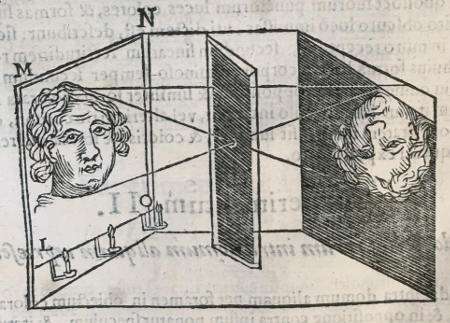
Athanasius Kircher
1646
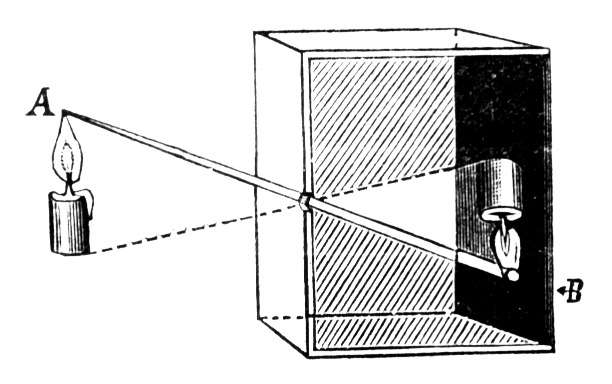
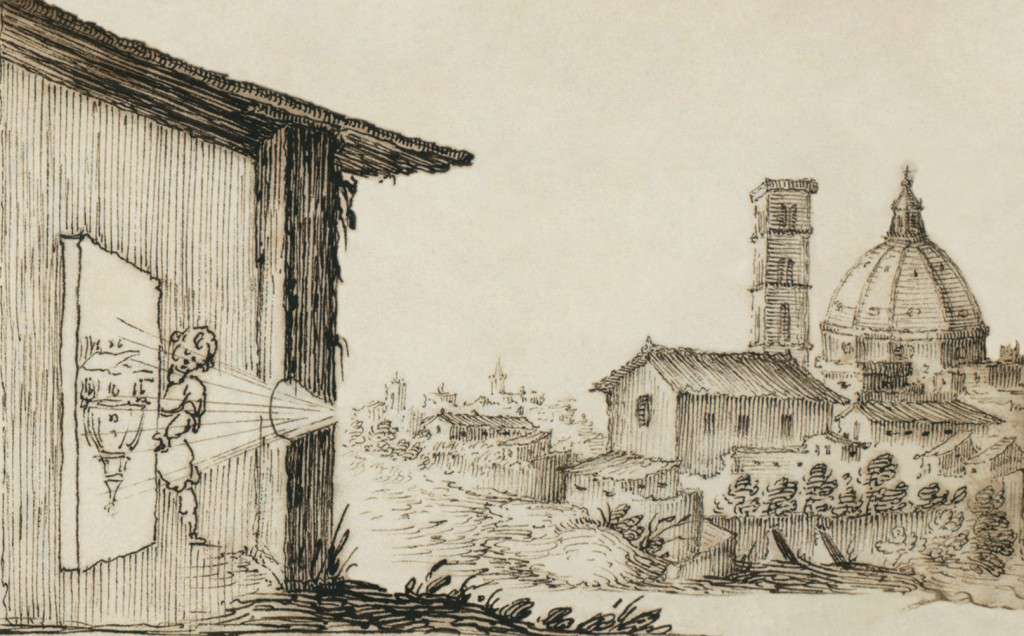
Unknown, possibly Italian
Seventeenth century
Pen and ink on paper
Library of Congress, Washington D. C.
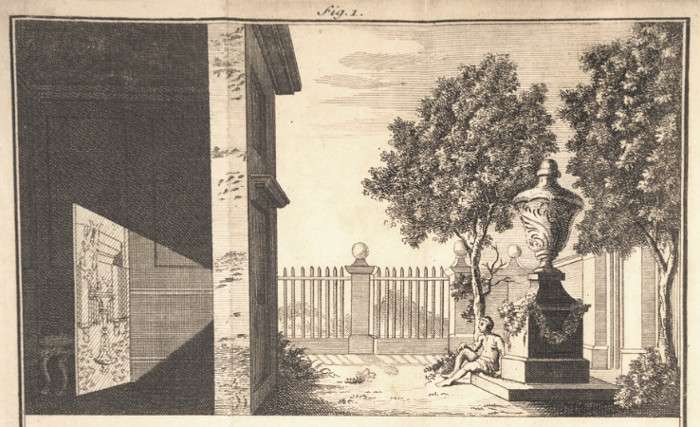
James Ayscough
1755
Printed by E Say for A Strahan, 1755
London
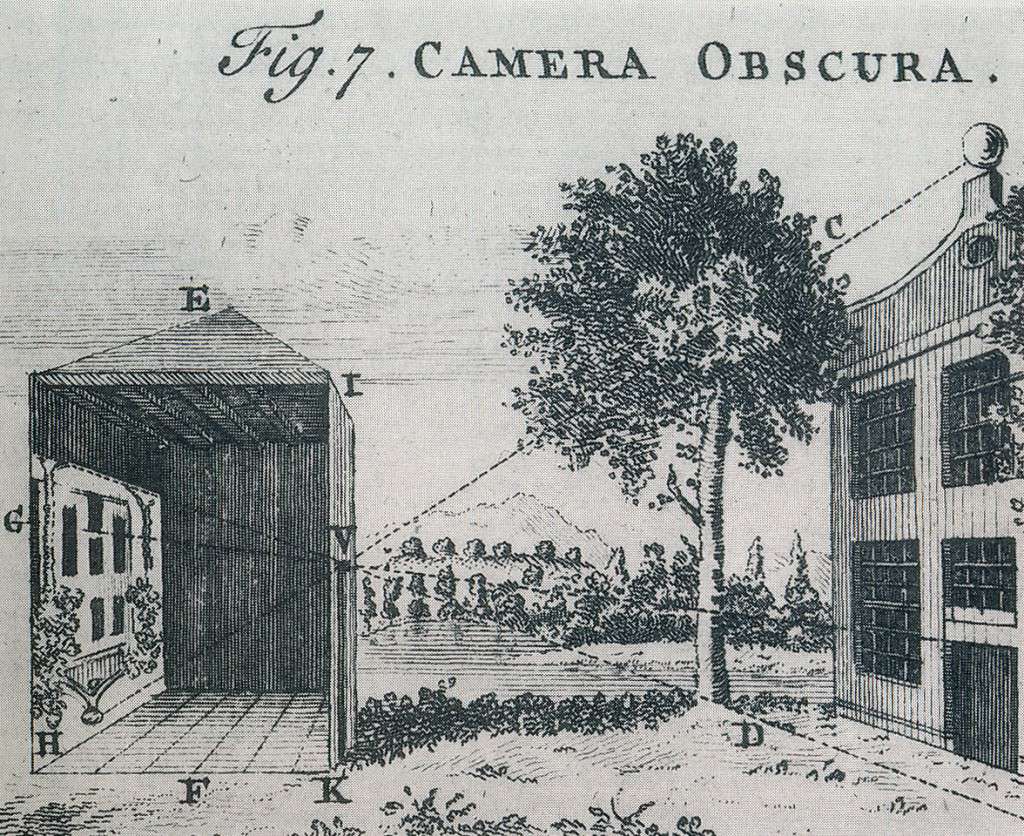
Thomas Jeffreys
1754
London: Printed for W. Owen
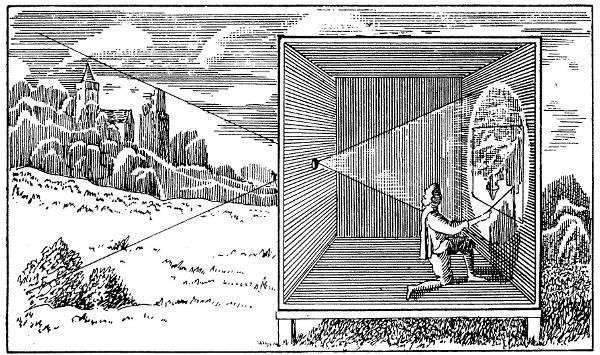
The image of the camera obscura has particular properties which makes it quite different from both reality and the photograph: its image is projected upside down, reversed left to right, and its luminosity is very low. A person entering the darkened room must wait a few minutes for his eyes to become accustomed before he can make sense out the projected image. The first phenomenon is due to the laws of optics while the second is due to the necessarily reduced size of the camera’s aperture.
History and Room-Type Camera Obscuras
The discovery and development of camera obscura stands at the crossroads of astronomy, perspective, optics, philosophy,John Locke, An Essay Concerning Human Understanding, (1689; Book II, XI, 17). magic and art. Those who were initially interested in the device were not only scientists (natural philosophers) but philosophers or inventors—but, until the mid-1600s, as far as we know, never practicing artists.
It is impossible to know by whom or when the camera obscura was first theorized. Almost certainly the device itself "was formulized from optical principles that had been accidentally discovered centuries earlier and that are as old as light itself. In the fifth century B.C., the Chinese philosopher Mo Ti noted the 'image-making properties' of a small aperture, although it was not instrumentalized. A century later, Aristotle (384–322 BC) was struck by the many crescent-shaped images of the sun that appeared on the ground beneath a tree during an eclipse of the sun, and attributed them to the small spaces between the leaves."Kaja Silverman, The Miracle of Analogy or The History of Photography: Part I (Stanford, CA: Stanford University Press, 2015). Those who has lived for some time in Italy in a house fitted with the typical slatted persiane (shutters) might have experienced the effect of a camera obscura by accident, particularly during the summer months when sun shines all day long. When the shutters are almost closed, every once in a while the direction of the sun rays and particular dispositions of the slats fortuitously create a tiny aperture that functions as a pinhole allowing the person inside the dark room to see part of the landscape outside the window projected on the floor or a wall.
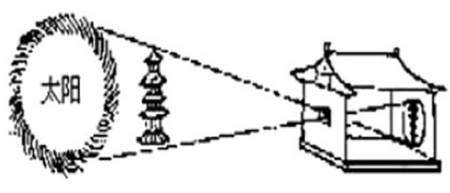
Jing jing ling chi
Zheng Fu-Guang zhu
In the third century B. C., Chinese writer Tuan Cheng-Shih discussed an inverted pagoda that he had seen form through a small hole made in a screen, although he attributed it to reflections in the nearby sea rather than a result of optics. In 1086–1088, the Chinese polymathic scientist and statesman of the Song dynasty Shen Kua (1031–1095), correctly explained the principles of the camera obscura—the focal point, the role of the pinhole and inverted images—using a fitting metaphor of an oar and its oarlock. He compared a ray of light to an oar in its oarlock (pinhole): when the handle is up, the blade of the oar is down, and vice versa. The property of image inversion was later illustrated using the canonical image of a pagoda (fig. 8) in the book Jing jing ling chi (Optical and Other Comments) by Zheng Fu-Guang zhu (1780–1853).
In 1038 A.D., the great Arab scholar Al-Hassan Ibn al-Haytham (Latinized as Alhazen; 965–c. 1040) described a working model of the camera obscura in his Perspectiva (i.e., the thirteenth-century Latin translation of his Kitãb al-ma). Alhazen did not actually construct the device because he and his followers were interested in the camera for what it revealed about the behavior of light, not for purposes of representation. He wrote:
If the image of the sun at the time of an eclipse—provided it is not a total one—passes through a small round hole onto a plane surface, opposite, it will be crescent-shaped… If the hole is very large, the crescent shape of the image disappears altogether and the light [on the wall] becomes round if the hole is round… with any shaped opening you like, the image always takes the same shape… provided the hole is large and the receiving surface parallel to it.

However, Alhazen's work influenced the English philosopher and Franciscan friar Roger Bacon (c. 1219/20–c. 1292; fig. 7), who was interested in optics. In 1267, Bacon created convincing optical illusions by using mirrors and the basic principles of the camera obscura. Later, he used a camera obscura to project the image of the sun directly upon an opposite wall. For centuries, the camera obscura was primarily used to watch solar eclipses because the human eye cannot tolerate the amount of light that floods into it when it looks directly at the sun. In any case, all of the first cameras were literally "dark rooms." Inside the room, one could see what was happening outside.
In 1490, Leonardo da Vinci (1452–1519) was the first to suggest that the camera obscura might be of interest to the artist.
If the facade of a building, or a place, or a landscape is illuminated by the sun and a small hole is drilled in the wall of a room in a building facing this, which is not directly lighted by the sun, then all objects illuminated by the sun will send their images through this aperture and will appear, upside down, on the wall facing the hole. You will catch these pictures on a piece of white paper, which placed vertically in the room not far from that opening, and you will see all the above-mentioned objects on this paper in their natural shapes or colors, but they will appear smaller and upside down, on account of crossing of the rays at that aperture. If these pictures originate from a place which is illuminated by the sun, they will appear colored on the paper exactly as they are. The paper should be very thin and must be viewed from the back.
These descriptions, however, would remain unknown until Giovanni Battista Venturi (1746–1822) deciphered and published them in 1797.
The oldest known drawing of a camera obscura (fig. 9) is found in De Radio Astronomica et Geometrica (1545), by the Dutch physician, mathematician and instrument maker Gemma Frisius (1508– 1555), in which he described how he used the camera obscura to study the solar eclipse of January 24, 1544. In fact, the oldest employment of the camera obscura, dating back to antiquity, was for astronomical purposes, for safely observing phenomena connected with the sun, in particular solar eclipses and sunspots. Since the stationary room-type camera obscura had no focusing mechanism, the only way the viewer could render its often blurry images sharper was to move a sheet of paper on which they were received back and forth until the point at which the image came into focus was found.
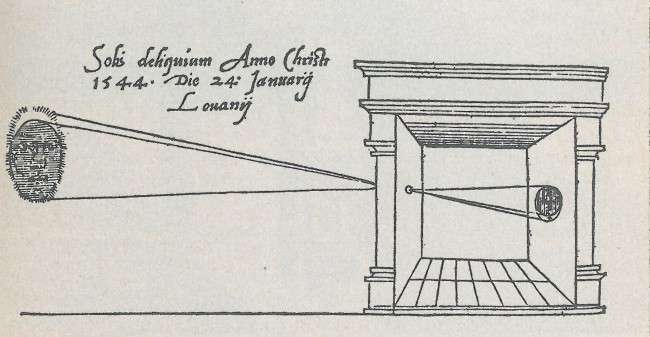
The Lens and the Diaphragm
The first documented mention of a "glass disc," probably a convex lens, used in conjunction with the camera obscura is in the Italian mathematician Girolamo Cardano's (1501–1576), De subtilitate, vol. I, Libri IV(1551). He suggested to use it to view "what takes place in the street when the sun shines" and advised to use a very white sheet of paper as a projection screen so the colors wouldn't be dull. Eight years later Giovanni Battista della Porta (1535?–1615), an Italian scholar, polymath and playwright, wrote that the camera obscura, which he called a "obscurum cubiculum," made it "possible for anyone ignorant in the art of painting to draw with a pencil or pen, the image of any object whatsoever" (Magiae Naturalis, first edition, 1558). With Della Porta's book, written in a simple and popular language, news of the camera obscura spread rapidly. Magiae Naturalis was so successful that it was translated into Arabic and several European languages, including Dutch. This explains why Della Porta was sometimes considered as the inventor of the camera obscura. Della Porta also compared the human eye to the camera obscura: "For the image is let into the eye through the eyeball just as here through the window."
As early as 1568, Daniele Barbaro (1513–1570), a Venetian patrician famous for his editions of the Roman architectural writer Vitruvius, had proposed that the camera be used explicitly for producing drawings in correct "perspective" in his La pratica della perspettiva (1568; fig. 10), one of the most influential texts on perspective at that time. He called it "a most beautiful experiment concerning perspective."
Close all shutters and doors until no light enters the camera except through the lens, and opposite hold a piece of paper, which you move forward and backward until the scene appears in the sharpest detail. There on the paper you will see the whole view as it really is, with its distances, its colors and shadows and motion, the clouds, the water twinkling, the birds flying. By holding the paper steady you can trace the whole perspective with a pen, shade it and delicately color it from nature.
While Leonardo encouraged his readers to make paintings that correspond with the images that appear inside the camera obscura, Barbaro actually recommended coloring them, most likely because, not being an artist, he naively assumed that laying in colors might be easily done. But perhaps more importantly, Barbaro described how to improve the image of the camera with a lens:
You should choose the glass [lens] which does the best, and you should cover it so much that you leave a little in the middle clear and open and you will see a still brighter affect.
By "covering it so much that you leave a little in the middle clear and open" Barbaro evidently meant that the diameter of the lens should be partially narrowed toward its middle, or "stopped down" in modern photography lexicon, in order to create a sharper image, thereby discovering the diaphragm. He used a bi-convex lens taken from a pair of ordinary spectacles used by old men—concave lenses suitable for short-sighted young people brought little success. A lens greatly improves the quality of the camera's image because it allows for a much larger aperture that significantly increases the luminosity of the projection (the pinhole camera produces an image so dim that it is useless for the purpose of painting). Barbaro himself also suggested it could be used to make copies of maps.
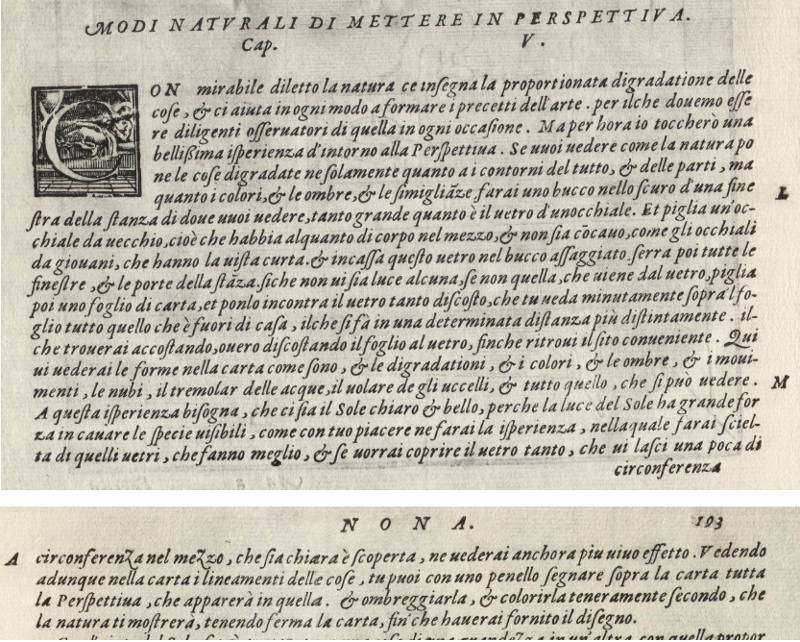
Daniele Barbaro
Publsihed: Venice, C. & R. Borgominieri, 1568
Following Barabaro's improvements of the lens, diaphragm and focusing mechanism, many writers began to recommend the camera as an aid to artists. For example, in 1521 Cesare Cesariano (1475–1543), an Italian painter, architect and architectural theorist, wrote that other than for astronomers and opticians (anyone who studies optics) the camera would be of great use for painters.
Some modern writers have proposed that seventeenth-century lenses were largely inadequate for the purpose of painting with a camera obscura. But, according to Cartesn Wirth, "it was not so much the technology of lens grinding, which was still fairly undeveloped at the beginning of the seventeenth century, but rather the limitations of glass technology that presented a problem with regard to producing an objective for a camera obscura with a significantly large diameter. Defects in the glass or an irregularity in grounding have devastating effects in astronomic optics. In contrast, the image of the projection in a camera obscura is fairly insensitive to such faults. Many of the defects that are disturbing in a telescope optic are barely–or not at all– perceptible in the projecting optic of the camera. An unbiased viewer with no concept of a perfect optic might even admire the multiple optical effects in the image of the projection rather than judging them to be a disturbance."Laura J. Snyder, Eye of the Beholder: Johannes Vermeer, Antoni Van Leeuwenhoek, and the Reinvention of Seeing (New York and London: W. W. Norton & Co Inc., 2016), 132–134.
Portable Camera Obscura
In 1572, the German mathematician Friedrich Risner (c.1533–1580) proposed a portable camera obscura drawing aid; a lightweight wooden hut with lenses in each of its four walls that would project images of the surroundings on a paper cube in the middle. The construction could be carried on two wooden poles, like a litter used to transport royalty. A very similar setup was illustrated in 1645 in Athanasius Kircher's Ars Magna Lucis Et Umbrae (fig. 11).
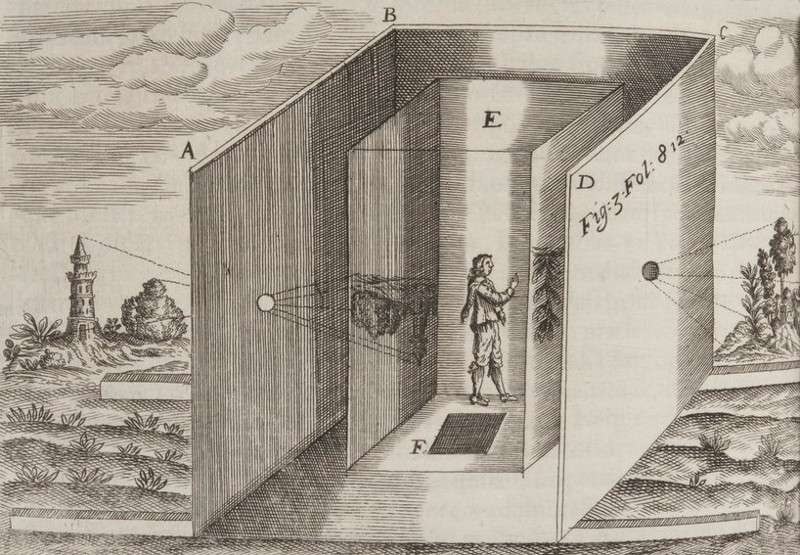
Athanasius Kircher
1645
Mirror
The use of a mirror in conjunction with the camera obscura was first suggested in a manuscript Theorica speculi concavi sphaerici by the Venitian Ettore Ausonio (1520–1570). In 1585, Giovanni Battista Benedetti (1530–1590) proposed the use of a mirror angled at 45 degrees to the direction of the light coming from the lens in order to right the image. In those times, however, mirrors were simply polished metal plates and as such were probably much less reflective than even the cheapest of today's mirrors—the highly reflective mirrors of today were invented somewhere around 1850 when opticians learned how to apply a shiny silver film to a polished flat piece of glass.

Ellsworth Foster and James L. Hughes
Publsiher: Ralph Durham Co. Chicago (IL)
1919
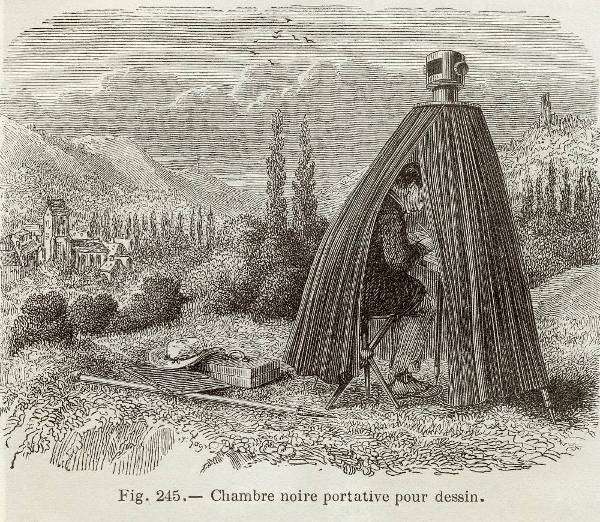
Adolphe Ganot
Engraving from: Cours de physique purement expérimentale et sans mathématiques... , chez l’Auteur
Paris, 1863, p. 404, n° 245.
In 1604, the term "camera obscura" (in Italian=dark room), was coined by the German astronomer Johannes Kepler (1571–1630) who developed the first portable camera obscura in the form of a tent (fig. 13), with a sheet of paper inside onto which the camera's image could be projected. According to a letter written to Francis Bacon by Sir Henry Wotton (1568–1639) who met Kepler in Linz in 1620, this portable camera had been invented by Kepler for sketching the complete 360° panorama (although Wotton reported that Kepler used the camera obscura to draw from nature Kepler claimed he used it "as a mathematician, not as a painter.")
He hath a little black tent which he can suddenly set up where he will in a field, and it is convertible (like Wind-mill) to all quarters at pleasure capable of not much more than one man, as I conceive, and perhaps at no great ease; exactly close and dark, save at one hole, about an inch and a half in Diameter, to which he applies a long perspective-trunke, with the convex glass fitted to the said hole, and the concave taken out at the other end, which extendeth to about the middle of this erected Tent, through which the visible radiations all the objects without are intromitted, falling upon a paper, which is accommodated to receive them; and so he traceth them with his pen in their natural appearance, turning his little Tent round by degrees, till he hath designed the whole aspect of the field: this I have described to your Lordship, because I think there might be good use made of it for Chorography [the making of maps and topographical views]: For otherwise, to make landskips by it were illiberal, though surely no Painter can do them so precisely. (Reliquiae Wottoniae, London 1651, pp. 413-414.)
In 1611, Frisian/German astronomers David (1564 –1617) and Johannes Fabricius (1587–1616) studied sunspots with a camera obscura, after realizing looking at the sun directly with the telescope could damage their eyes. They are thought to have combined the telescope and the camera obscura into camera obscura telescopy. From 1612 to at least 1630, Christoph Scheiner (c. 1573–1650), Jesuit priest, physicist and astronomer in Ingolstadt, would keep on studying sunspots and constructing new telescopic solar-projection systems ((fig. 14). He called these "Heliotropii Telioscopici," later contracted to helioscope. For his helioscope studies, Scheiner built a box around the viewing/projecting end of the telescope, which can be seen as the oldest known version of a box-type camera obscura. Scheiner also made a portable camera obscura.
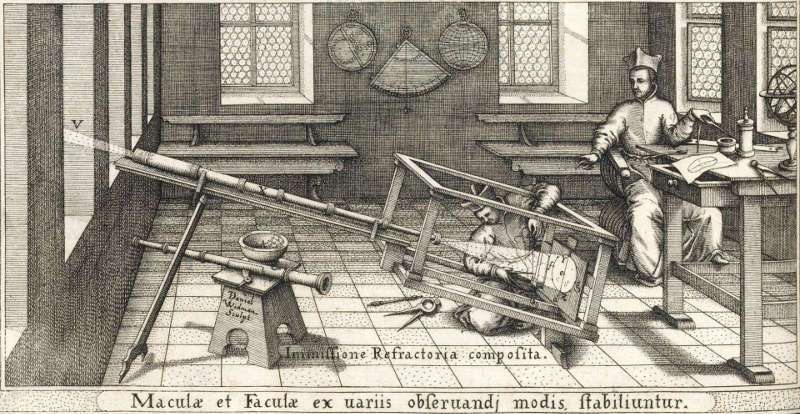
Rosa Ursina sive Sol ex admirando facularum & macularum suarum phoenomeno varius. (p. 150)
Christoph Scheiner
1626–1630
Published Bracciano: Andreas Phaeus at the Ducal Press, 1626–1630
Box-Type Camera Obscuras
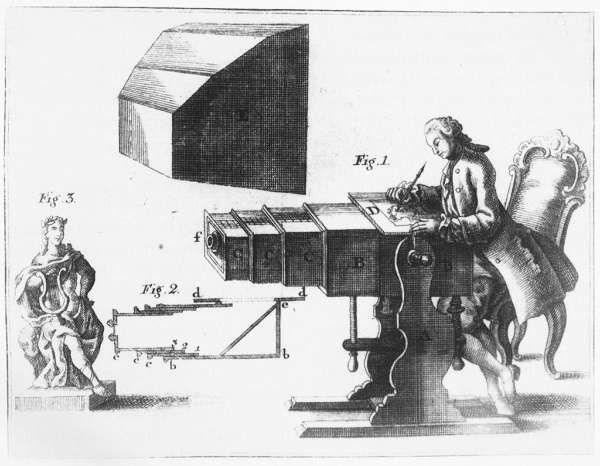
"By 1572, the room-type camera obscura had been shrunk down to a small, portable room, which can be thought of, after all, as a very large box. However, when pin-pointing the first appearance of box-type camera obscuras—devices in which the lens, the mirror and the screen on which the image was projected were put inside a small wooden box—most writers date it to around the mid-seventeenth century, nearly a hundred years later. Gaspar Schott (1608–1666) described a portable camera obscura in his Magia Universalis, in 1657, and in 1669 the British philosopher Robert Boyle (1627–1691), in his paper "Of The Systematicall And Cosmical Qualities Of Things, " (1669) drew landscapes in a box-type camera, perhaps similar to figure 15, he claimed to have constructed 'several years ago.'"Carsten Wirth, "The Camera Obscura as a Model of a New Concept of Mimesis in Seventeenth-Century Painting. Inside the Camera Obscura–Optics and Art under the Spell of the Projected Image," Max Planck Institute for the History of Science, 2007, 159. The portable camera fitted with a lens, mirror and translucent screen (fig. 11) became the standard configuration from the late seventeenth century onward.
The simple portable camera (fig. 16 & 18)) is essentially a photographic camera without a light-sensitive film or plate. So simple but so effective is the device that it has changed only in size and decoration since the sixteenth century. In portable form, the camera obscura became popular for recording landscape and city views. Using a system of lenses and mirrors that allowed the image to appear on a translucent screen, draftsmen could trace the views to produce early versions of tourist snapshots. The booth-sized version of the camera obscura (fig. 17) was also useful to scientists interested in the behavior of light. The English natural philosopher, architect, polymath and tireless inventor Robert Hooke (1635–1703), built different types of portable cameras for making illustrations for the travel guides or topography. One particularly curious contraption was a "wearable" beak-like object (fig. 19) which, according to his description, was an "an instrument of use to take the draught, or picture of any thing" Philosphical Experiments and Observations (1762). At the time it had become evident that the lens in the camera should be as "bright" as possible, that is, have as large a diameter as possible. Hooke suggest using as a lens a "[...] Glass, which the larger it is the better, because of several Tryals that may be made with it, which cannot be made with a smaller [one]." In 1685, Johann Zahn (1641–1707) was probably the first to have designed a camera obscura that could be manually focused by moving the lens, instead of relocating the screen (fig. 18 & 21).
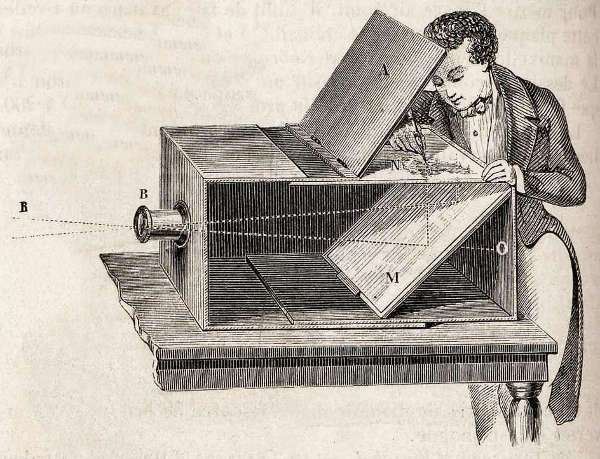
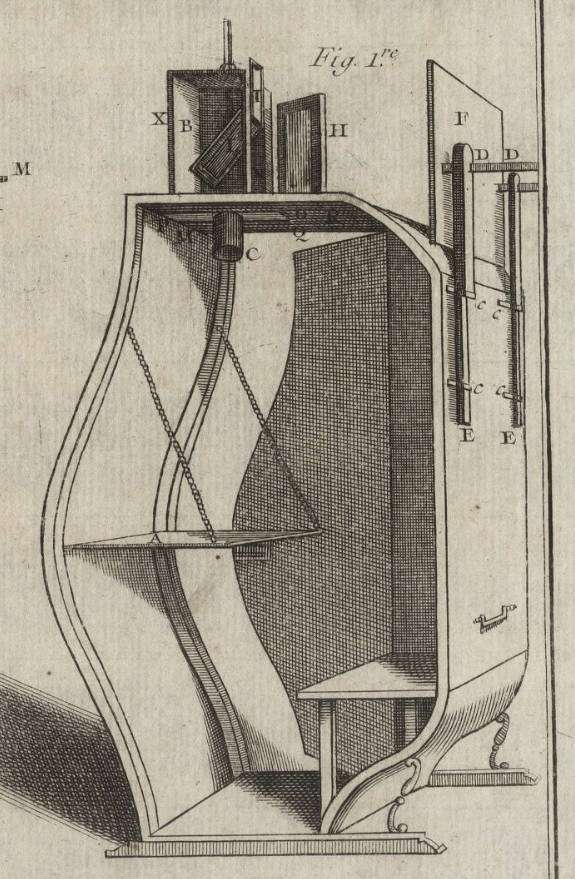
C. A. Jombert
Paris, 1755 (p. 136)
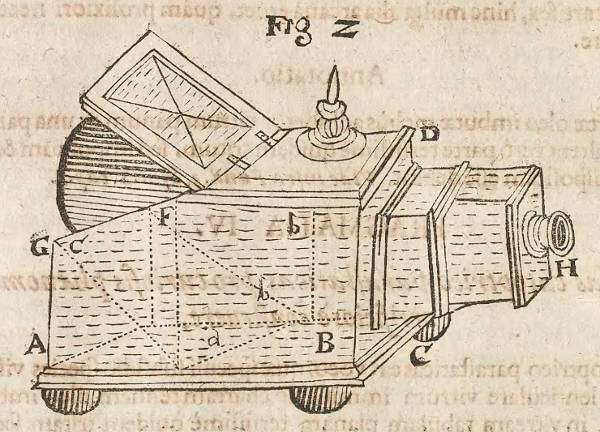
Johann Zahn
Publisher: Sumptibus Johannis Christophori Lochneri Bibliopolæ, typis Johannis Ernesti Adelbulneri, Norimbergæ
1702
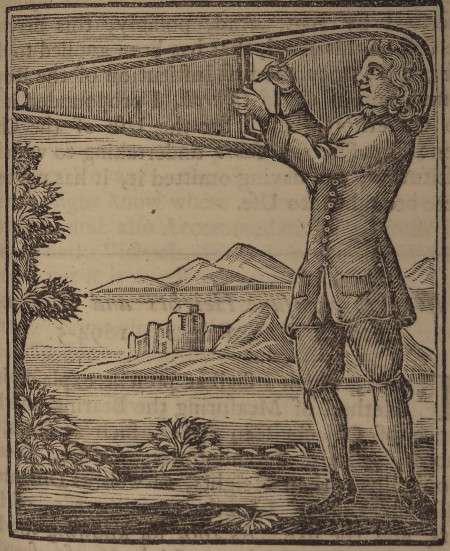
Robert Hooke
London, 1726
Ink on paper
University of Michigan
Camera obscuras of the period were fitted with a single converging lens. There is no mention of any use of multiple lens configuration needed for telescopy in relation to the device. In the time of Vermeer, lenses could be easily purchased from itinerant peddlers—lenses were primarily produced for spectacles—but if one needed a particular lens, for example, for a telescope, they could be ground to specification by a lens grinder. To be sure, a lens improves the luminosity of the image considerably, but it comes with some serious drawbacks. Everything towards the edges is blurry, color fringes appear around bright objects and objects that occupy different planes in space are not all in focus at the same time, even if they are located at the middle of the image. If, for example, Vermeer had brought into focus the foreground chair in The Art of Painting with a camera obscura, the wall-map and the chandelier would have appeared more as colored clouds than solid objects. The individual elements of both objects would have blended completely together and been impossible to distinguish, much less trace. This problem could be temporarily remedied by refocusing, i.e., moving the position of lens back and forth, but the objects that were previously in focus become blurry. There is no way that all planes can be brought into a focus with a single lens, no matter what its shape or configuration.
Some authors have written that color is intensified in the camera obscura image, but this is not objectively proven by any means. Moreover, even the best image of the camera has an overall milky quality—one never has the sensation that absolute black can be perceived. Goethe (1749–1832) noted that the image cast by the lens causes everything to appear "as covered with a faint bloom, a kind of smokiness that reminds many painters of lard, and that fastens like a vice on the painter who uses the camera obscura." But unlike the reflections in a mirror or water, the projection of the camera is perceived as relatively flat, a fact which is particularity advantageous for the painter. In any case, even in the best cases the image produced by the camera is never as sharp, contrasted or as colorful as any painting by Vermeer.
The Camera Obscura in the Time of Vermeer
Thus, the camera obscura was well known in the time of Vermeer. As early as 1622, ten years before Vermeer was born, news of the camera obscura circulated in the Netherlands. In that year, Constantijn Huygens (1596–1687), who maintained contacts with eminent artists such as Rubens (1577–1640), Van Dyck (1599–1641), Rembrandt (1606–1669) and perhaps Vermeer himself, purchased a portable camera obscura in LondonConstantijn Huygens, De Briefwisseling 1608–1687, vol. I, 94, quoted in Colie, 'Some Thankfulness to Constantine,' 106. from the Dutch engineer and inventor Cornelis Drebbel (1572–1633), and enthusiastically wrote about the image that it produces:
I have at home Drebbel's other instrument, which certainly makes admirable effects in painting from reflection in a dark room It is impossible to express its beauty in words. The art of painting is dead, for this is life itself: or something higher, if we could find a word for it. Shape, contour and movement come together naturally, in a way that is altogether pleasing.
Huygens would also report the names of at least two painters who knew about the device, which in his words was "now-a-days familiar to everyone…" Following the example of earlier Italian writers, Samuel van Hoogstraten (1627–1678), an accomplished Dutch painter and author of the widely read tract of painting Inleyding tot de Hooge Schoole der Schilderkonst (1678), recommended the camera obscura to painters:
I am certain that the sight of these reflections in the darkness can be very illuminating to the young painter’s vision; for besides acquiring knowledge of nature, one also sees here the overall aspect which a truly natural painting should have.
A second time he calls the optical machine "a picture-making invention with which one can paint by means of reflections in a closed and darkened room everything which is outside." However, even though the device was enthusiastically recommended for painting, at least one painter is know to have concealed his familiarity with it, leaving open the possibility that other painters may have used it but chose to conceal their involvement.
Thus, as an aid to painting per se, the camera obscura cannot be considered absolutely innovative in Vermeer’s time: it may be said that a fair number of Dutch painters knew it, and a few probably worked with it, although never on a systematic basis. No documented source that suggests that Vermeer knew of or used a camera obscura has come down to us.
"In Delft, vision-extending and vision-transforming instruments such as the camera obscura must have been readily available. They were the passion of Anthonie van Leeuwenhoek (1632–1723), an industrious researcher now best known for his discovery of micro-organisms through the microscope. It is almost impossible to imagine that these exact contemporaries, both baptized in 1632 and both high achievers in their fields, would not have come across each other in the small city of Delft.Mariët Westerman, "After Iconography and Iconoclasm: Current Research in Netherlandish Art, 1566–1700," The Art Bulletin 84 (2002): 226. It has also been suggested…that Vermeer developed an interest in optics through a connection with the painter Carel Fabritius (1622–1654), who moved to Delft in about 1650; or, via Fabritius, with his friend Van Hoogstraten of Dordrecht. Both men were fascinated by the trompe-l’oeil and perspective illusion.Philip Steadman, Vermeer’s Camera: Uncovering the Truth Behind the Masterpieces (Oxford: Oxford University Press, 2002), 21. In any case, the reflected image of the camera obscura, no matter how novel it may have appeared in the seventeenth century, was probably a bit more familiar to the Dutch people who were used to living in a world of reflections, constantly seeing their houses, trees and skies mirrored in canals and lakes.Philip Steadman, Vermeer’s Camera: Uncovering the Truth Behind the Masterpieces (Oxford: Oxford University Press, 2002), 21. It is said that Constantijn Huygens II, a skilled lens maker and draughtsman made a series of landscapes that presumably bear the hallmarks of the camera obscura, although there is no documented evidence that the device was actually used in this case (fig. 20).
There is only one source that specifically claims that painters of Vermeer's time actually used the camera obscura as an aid to their painting. G. J. s'Gravesande, who was born thirteen years after Vermeer's death, wrote: "Several Dutch painters are said to have studied and imitated, in their paintings, the effect of the camera obscura and its manner of showing nature, which has led some people to think that the camera could help them to understand light or chiaroscuro. The effect of the camera is striking, but false."
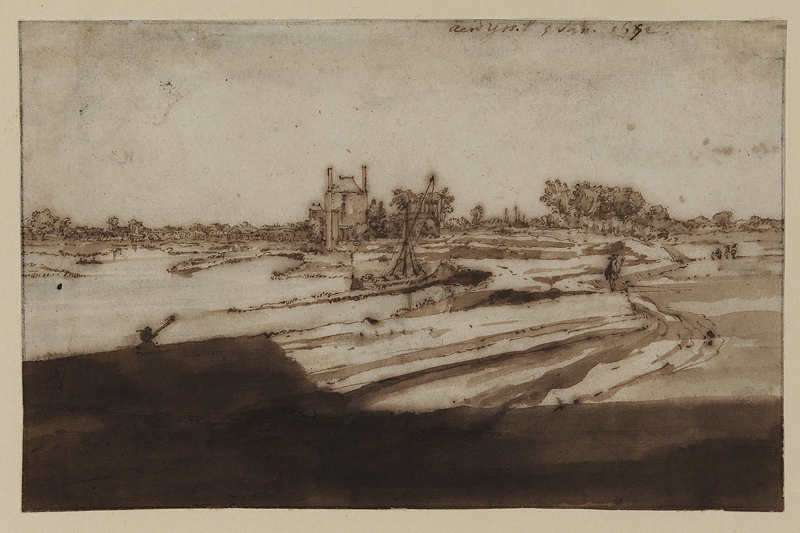
Constanitjn Huygens
5 June 1672
Pen and ink, Sepia ink, Watercolour
The Samuel Courtauld Trust, The Courtauld Gallery, London
The Italian landscape painters Canaletto (1697–1768), and Bernardo Bellotto (c. 1721–1780) are said by some art historians to have used the camera to create perspective views of Venice and other cities. Sir Joshua Reynolds (1723–1792) constructed a small portable camera, presently conserved in the Science Museum of London, for portrait painting.Martin Kemp, The Science of Art: Optical Themes in Western Art from Brunelleschi to Seurat (New Haven: Yale University Press, 1992). After that, the camera was never taken seriously among artists although it continued to be employed by topographical draftsmen and as a source of entertainment to this very day.
It should be remembered that when the device began to be used by professional painters in the eighteenth century, it was never intended as to aid to capture light or darkness, or reproduce color. When mentioned in relation to painting it was almost universally understood to be useful in rendering a complex scene into its outlines, reducing a landscape, for instance, into a series of lines, zones, or bands.
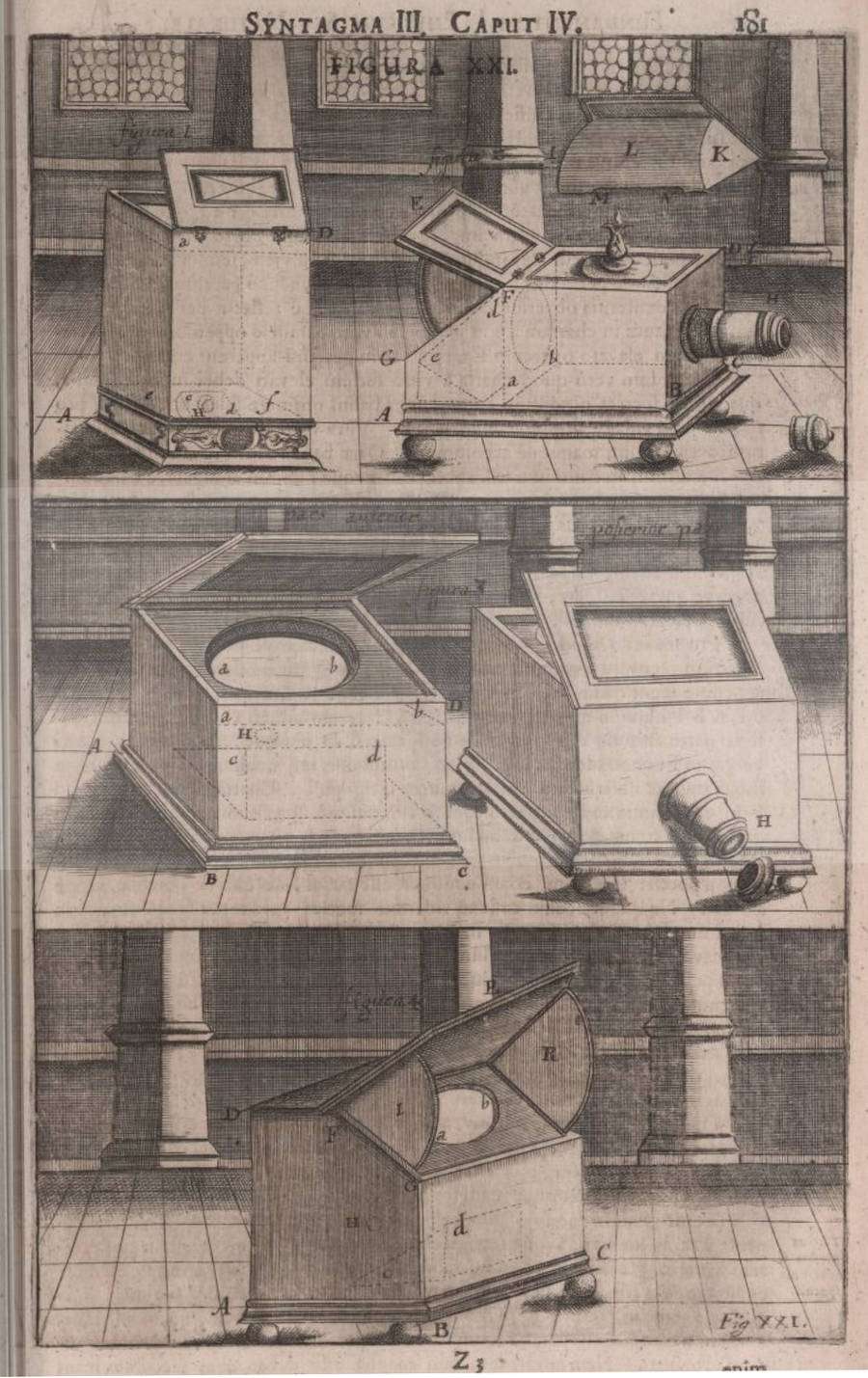
Johann Zahn
1658
Published: Herbipoli, Würzburg, Germany
But the future of the camera obscura lay not in its usefulness to painters, but as an indispensable precursor to the modern photographic camera.